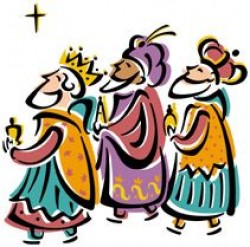Dado el crecimiento de la población hispana en los Estados Unidos, hay unas personas que se preocupan de que Papá Noel (Santa Claus) se encuentra con competencia muy seria. Es porque en algunos países latinoamericanos los Tres Reyes Magos (The Three Kings a.k.a. The Three Wise Men) juegan el papel de Santa. Montados en camellos, ellos visitan las casas de niños y llevan regalos y juguetes por la noche antes del seis de enero, “La Fiesta de Epifanía”. Para este trío de sabios ricos el acto de cruzar la frontera entre los Estados Unidos y México, llevando un montón de juguetes, mientras evitan las patrullas y narcotraficantes, es fácil. Se debe recordar que después de su jornada a Belén para ver el infante Jesucristo en el siglo I, los reyes, al prepararse de regresar al oriente tuvieron que cambiar su camino por el desierto a fin de no encontrarse bajo la inquisición del el rey Herodes, según el góspel de San Mateo. Cuando se considera la capacidad y experiencia de los Tres Reyes Magos, se puede ver con claridad que el monopolio benévolo de Papá Noel en América del Norte se va acabando.
Pero espera un momento . . . No se puede simplemente tirarlo al Gordo bajo del trineo. A diferencia de Rudolph, Papá Noel tiene un legado anciano a pesar de su afinidad del estilo pagano. Este tipo se considera un venerado santo desde el siglo IV por la Iglesia Católica y la Iglesia Ortodoxa. De hecho, se documenta que Papá Noel le pegó a un sacerdote y este golpe lo hizo dormir al pobre sacerdote durante el primer concilio de Nicea en el 325 d.C. Aparte de ser capaz de “Un Golpe Sagrado” su equipo proporciona una ventaja poderosa. El trineo y los renos voladores le permiten movilidad impresionante en la nieve y permiten la supremacía aérea total para el entregamiento de regalos.
Aunque hay fanáticos de los dos lados que se han criticado el uno al otro en varios casos con rumores de infracciones aduaneros, fraude de seguridad social y hasta acusaciones de paganismo, una batalla entre Papa Noel y Los Reyes no es muy probable. No creo que los niños tengan que escoger entre Papá Noel y Los Reyes por fuerza sino por un sistema muy práctica que fue instilada en la época de la fundación del calendario cristiano. Afortunadamente se celebra el nacimiento de Jesucristo el 25 de diciembre y la Epifanía se celebra el seis de enero. Por eso, no existe un verdadero conflicto de intereses y el acuerdo les permite a los niños de ambas culturas una doble ganancia cuando expanden sus tradiciones y se animan al espíritu navideño el cual es la generosidad, la esperanza y la paz en la tierra para los hombres de buena voluntad.
English Translation:
With so many families from Latin America now living in the US, many are concerned that Santa Clause is facing some serious competition for work during the Christmas Holiday Season. This is because in Mexico and many Latin American countries, “Los Tres Reyes” (The Three Kings a.k.a., the Wise Men) visit the homes of children on camelback to bring gifts and leave them for children on the eve of Jan. 6, to celebrate the Epiphany. For this wise and determined trio, crossing the US-Mexico Border through the desert with millions of gifts, all the while avoiding the US Border Patrol and vicious narco-gangs is nothing new. Following the original journey across the desert to see the infant Christ, they managed to evade an angry King Herod according the Gospel account in the book of Matthew. It’s clear that the demand for the Three Kings is increasing in the United States, despite the fact that Santa (Papá Noel) provides the same overnight service to Latin America.
But let’s not throw the big guy under the sleigh yet. Santa is a force to be reckoned with. Despite having pagan taste in clothes and living room décor such as Christmas trees, he is a venerated saint from the fourth century, and unlike Rudolph, he has some serious “holiday cred.” It is documented that he literally “knocked a brother out” during the First Council of Nicaea in 325AD. Not only can he put the holy smack down, his equipment provides a technical edge with a high-performance sleigh and flying reindeer that afford him ground mobility in the harshest of snowy conditions and total air superiority for delivering gifts at incredible speeds.
While supporters of each side have on occasion mentioned criticisms ranging from customs violations (on both sides) to accusations of paganism, it appears as though a clash is unlikely and children won’t be forced to pick a side. Fortunately, a practical arrangement was made at the inception of the Christmas calendar. By celebrating the birth of Christ on Dec. 25 and the Epiphany on Jan. 6 (the time in between being the original 12 days of Christmas in the song), the arrangement allows children everywhere to double dip by expanding their traditions in the spirit of the season—a spirit that spreads generosity, hope and goodwill across every language, border and culture on the planet.















